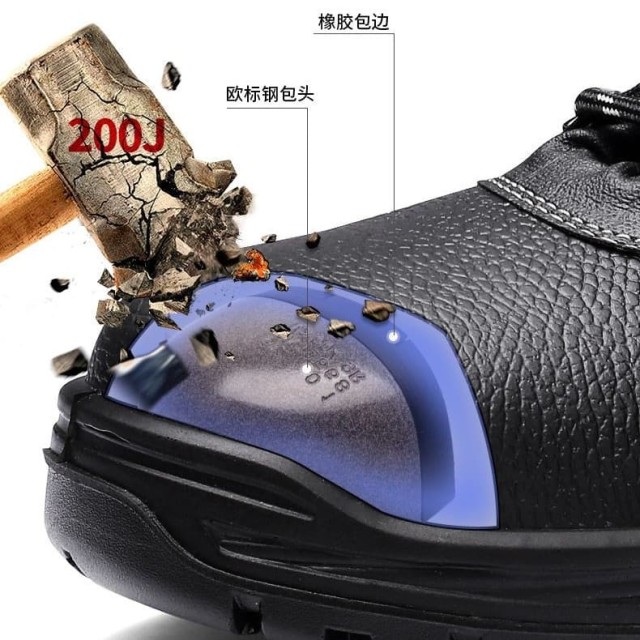When workplace hazards loom, the right safety footwear can mean the difference between a close call and a life-altering injury. Modern work shoes integrate specialized technologies to address specific occupational risks—from crushing impacts to electrical surges. This guide breaks down how key safety features actively protect workers, backed by industry standards and real-world performance data.
How Steel Toes Prevent Crush Injuries in Heavy-Duty Environments
Steel toe caps remain the gold standard for crush protection in industrial settings. These reinforced shields deflect or absorb the force of falling objects, heavy equipment, or compression hazards. Here’s how they work:
- Impact Resistance: ASTM F2413-18 standards require steel toes to withstand impacts of up to 75 foot-pounds (simulating a 50-pound object dropped from 1.5 feet). The steel cap distributes force laterally, reducing direct pressure on toes.
- Durability Trade-offs: While steel offers unmatched strength, it can dent permanently upon extreme impact, unlike composite materials that may rebound.
- Ideal For: Construction, manufacturing, and logistics workers exposed to heavy machinery or falling tools.
Did you know? A single steel toe boot can prevent up to 90% of foot injuries in high-impact scenarios, according to OSHA incident reports.
Electrical Hazard Protection: What It Covers (and What It Doesn’t)
Electrical hazard (EH-rated) shoes are engineered to minimize risks in environments with live circuits or static discharge. Key protections include:
- Insulating Materials: Non-conductive rubber or composite outsoles block electrical currents up to 600 volts in dry conditions (per ASTM F2413-18).
- Static Dissipation: For sensitive electronics work, EH shoes safely ground static charges below 1.0 megaohm resistance.
Limitations: EH ratings do not guarantee protection in wet conditions or against high-voltage direct contact. Workers handling live wires still require additional PPE like dielectric overshoes.
Real-world application: Electricians wearing EH-rated boots reduce electrocution risks by creating a critical barrier between their feet and energized surfaces.
The Science Behind Slip-Resistant Outsoles: Testing and Real-World Performance
Slip-resistant soles combat one of the top causes of workplace injuries—falls. Their effectiveness hinges on:
- Tread Design: Multi-directional lugs and wide grooves channel liquids away, increasing surface contact.
- Material Chemistry: Oil-resistant rubber compounds maintain grip on greasy surfaces, a requirement for OSHA-compliant kitchen or factory footwear.
- Testing Metrics: ANSI/ISEA 137-2019 evaluates slip resistance on wet, oily, and inclined surfaces. Top-performing soles achieve coefficients of friction above 0.47.
Pro Tip: Slip resistance degrades over time. Inspect tread depth quarterly—worn soles can increase slip risks by over 60%.
Composite vs. Steel Toes: Weight, Safety, and Industry Compliance
| Feature | Steel Toe | Composite Toe |
|---|---|---|
| Weight | Heavier (~30% more) | Lightweight |
| Temperature | Conducts heat/cold | Insulates |
| Impact | Higher resistance | May rebound post-impact |
| Best For | Extreme crush risks | Airport security, cold storage |
Both meet ASTM F2413-18 standards, but composites excel in weight-sensitive or temperature-extreme roles, while steel dominates in heavy industry.
Case Studies: When Safety Features Prevented Workplace Accidents
- Construction Site Near-Miss: A steel toe boot absorbed the impact of a 20-pound steel beam dropped from 10 feet, sparing a worker from fractures.
- Hospital Kitchen Fall Prevention: Slip-resistant soles prevented a chef from falling on a grease spill, avoiding potential spinal injuries.
- Electrical Incident Mitigation: An electrician’s EH-rated boots diverted a 480-volt shock, limiting injury to minor burns.
These examples underscore how purpose-built safety footwear directly reduces workplace injuries.
Upgrade Your Safety Standards with 3515 Footwear
Whether you’re equipping a construction crew or stocking inventory for industrial suppliers, 3515’s range of ASTM-compliant work shoes delivers tailored protection against workplace hazards. Our expertise in bulk manufacturing ensures consistent quality across steel toe, EH-rated, and slip-resistant designs—because every worker deserves safety without compromise.
Explore how 3515 can customize safety solutions for your workforce today.
Products You Might Be Looking For:
View steel toe work shoes for heavy-duty protection
Explore customizable safety footwear options
Related Products
- Wholesale Mesh Steel Toe Safety Shoes with Dial Closure Factory Production
- Wholesale Anti-Smash & Puncture-Proof Safety Shoes Custom Manufacturing for Brands
- Athletic Safety Shoes with Dial Closure & Steel Toe for Wholesale & Custom Manufacturing
- Wholesale Safety Footwear Manufacturer for Bulk & Custom OEM Orders
- Safety Footwear Wholesale Manufacturer for Custom OEM/ODM Production
Related Articles
- How to Prevent Foot Injuries from Steel Toe Boots Without Sacrificing Safety
- How Steel Toe Boots Combine Safety Compliance with All-Day Comfort
- How Steel Toe Shoes Meet Safety Standards and Prevent Workplace Injuries
- How Steel Toe Shoes Prevent Injuries: The Science Behind Workplace Safety
- Steel Toe Work Boots: Balancing Safety and Comfort for Demanding Jobs



















